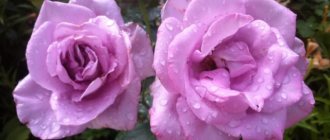Plants planted in public gardens, city gardens and other public places, although they please more people, receive much less care and attention than their relatives from private lands. At the same time, they adequately cope with their decorative role. Among them is the park rose - an unpretentious shrub with flowers of amazing beauty.
Park rose - what is it?
The beauty of this flower has been glorified by poets and appreciated by aesthetes since time immemorial. It is amazing to see large, strong bushes strewn with flowers that calmly tolerate both drought and severe frosts. Few people know that the park rose is, in fact, a cultivated variety of rose hips, which explains the lack of special care procedures. The breeders did a great job, enhancing the decorative properties of the plant while maintaining its vitality.
What does a park rose look like?
The ornamental shrub of the improved rosehip can reach one and a half meters in size. Such tall park roses can only be found in especially favorable conditions for them, but the average height of the plant fluctuates around a considerable mark of 1 m. The shrub looks strong and lush, boasts abundant flowering, and it begins already at the beginning of summer and lasts about a month.
At this time, the park rose simply enchants with its charm. It is covered with double scale-like flowers, in which you can count at least a hundred petals. At the same time, the possible color range of this plant is strikingly diverse: from light cream to rich purple, including soft pink, bright red and even sunny yellow buds. In addition, during the flowering period, the park rose is surrounded by a subtle, pleasant aroma, which makes it even more attractive.
Winter-hardy
Frost-resistant varieties are suitable for planting in central Russia. They tolerate cold well and are undemanding in care, so even beginners can cope with their cultivation. Despite this, park types of roses will delight you with abundant blooms and a delicate aroma.
Chippendale
The variety was bred by German breeders and belongs to the Shrub group. The flowers are hybrid tea, double, up to 12 cm in diameter. The buds are dense, fragrant, orange in color, gradually turning pink. The leaves are light, with a glossy tint.
Chippendale loves sunlit, fertile areas with well-drained soil. If you properly care for the crop, it will bloom until frost. The variety is resistant to rain, but during drought it is often affected by powdery mildew. In winter, the plant without shelter can survive frosts down to -20 degrees. If the plant is covered, it also feels good in the Siberian regions.
Golden Celebration
A climbing variety of park roses bred by D. Austin. The flowers have a fairly large diameter - up to 16 cm, and are collected in brushes of 5 pieces. The shade of the buds is yellowish. The leaves are light, with a glossy tint.
Related article:
7 most beautiful varieties of roses that will look great in any garden
The bush grows up to 2 m in height. Its width is approximately equal to its height. The shoots are arched and drooping. Flowering begins in summer and continues until frost. The bush emits a delicate aroma. The buds do not lose their shape after rain. The crop is disease resistant, but can be affected by black spot.
William Shakespeare
An amazingly beautiful variety with amazingly beautiful inflorescences of a rich lilac hue with a reddish tint. Buds with a large number of petals are collected in brushes. This is another rose from D. Austin. The bush is small, grows up to 1.2 m, with branched shoots. Flowering is continuous throughout the summer.
The buds do not fade in the sun and are resistant to humidity and disease. In winter they tolerate frosts down to -26 degrees, but to preserve plants in Siberian conditions, shelter is required.
New Dawn
A climbing bush with pale pink inflorescences, bred by American breeders. The buds are semi-double, reaching a diameter of 10 cm. They have a medium-intensity aroma and gradually fade in the hot sun.
Without shelter, this variety can survive frosts down to -26 degrees. In the conditions of the Middle Zone and Siberia, it is advisable to bend the plant to the ground for the winter and cover it with non-woven material.
What is the difference between a park rose and a hybrid tea?
Another well-known class of varieties of this flower is also the result of the work of breeders. We are talking about a hybrid tea rose, which has about 10 thousand varieties and breaks records in popularity among gardeners. Obtained as a result of crossing the tea and remontant, she rightly received the title “noble” for her strict and elegant beauty. The difference in origin determined the striking difference between the park rose and the hybrid tea rose, and they can be easily distinguished by:
- Shape and height of the bush
. Hybrid tea rose blooms on a medium-sized, 60 to 100 cm in height, strictly vertical shrub. Planting several of these plants of the same species looks especially advantageous. At the same time, lush park roses, due to their size, can play a solo role in the garden. - The appearance of the flower
. The hybrid tea rose looks as if it was carved by a jeweler: in the large open buds, each petal occupies its clearly defined place, which gives it grace and harmony. The park one is not so refined, but it has more petals and looks more magnificent and terry. - Care requirements
. All varieties of hybrid tea roses are very capricious: they are afraid of frost and are susceptible to attacks by parasites, which distinguishes them very unfavorably from the persistent park rose.
Features of care
You have seen the main photos and already know that this type of plant is very easy to use. There is no need for insulation; you can limit yourself to a light shelter. In spring, plants are fertilized after long and abundant watering. It is recommended to fertilize only after a year. From spring to mid-summer, the Remy Martin rose and most other varieties are watered 2-3 times a week. Since it is extremely undesirable to water any plants in the heat, this should be done in the early morning or late evening.
Watering is done right down to the root. Make sure that water does not get on the flowers and leaves. In August and September, the plants are not watered. For example, in the Pichard rose this can cause quite abundant growth of young shoots. Unlike other varieties, which often get sick and are attacked by robbers, this happens much less often with park varieties.
Perhaps your main task when caring for the Ferdinand Richard rose and some others will be timely pruning.
In remontant species, flowers can form even on young shoots. Consequently, the more main branches there are, the richer the bush will be.
Every year the bushes grow more and more and, in the end, lose their decorative appearance. The problem can be solved if you perform anti-aging pruning in a timely manner. In the fall, you will need to trim all the old stems to the very base, remove small shoots and branches that have not bloomed for a long time. To cover the cuts, use oil paint or garden paint.
Pay special attention to such care items as preparation for wintering. This is especially true for young plants, which are not yet so resistant to the unexpected “whims” of winter. The bushes can be covered with earth and the branches can be wrapped in craft paper. Although the shelter is simple, it provides a quiet winter, and at the end of winter it will definitely save your roses from the cold wind and unexpectedly bright sun.
What is the difference between a park rose and a climbing rose?
Some gardens are decorated with flowering shrubs that wrap around columns, arbors or arches. They are called climbing roses. This is not the name of the variety, but only a feature of stem growth that can be found in both real roses and cultivated rose hips. Climbing trees differ from park climbers in two main parameters:
- Feature of growth
. The park rose is an upright lush bush that is not inclined to entwine anything nearby. The stems of climbing roses need support, as they are long and tenacious. - Winter hardiness
. The shoots of climbing roses are sensitive to cold and very tender, so before frost they need reliable shelter, unlike strong park roses.
Useful Tricks
Experienced gardeners simplify the process of growing roses with the following techniques:
- mulch the soil with the bark of coniferous trees or juniper. Such mulch, in addition to its usual functions - retaining moisture, preventing overheating of the soil and protecting against weeds - will not allow pests to develop;
- The distance between bushes is chosen for reasons not only of aesthetics, but also of ease of maintenance of each plant. Depending on the variety, it is 30-100 cm;
- Before planting, the roots of the seedling are dipped in a mixture of clay mash and mullein in a 2:1 ratio. The consistency is similar to sour cream;
- during the planting process, pouring soil into the hole, water it layer by layer - then there will be no voids;
- so that there are more flowers on the shoot of a climbing rose, it is placed on a support as close to a horizontal position as possible. This stimulates the appearance of side shoots - they produce flowers;
- “blind” shoots (that do not produce flowers) are laid on the ground and pinned: this leads to the appearance of flower buds;
- to bend down a thick shoot, they dig it up on one side;
- so that the roses winter well, the last pruning is done no later than August;
- In order to prevent the spread of weeds, they frame the rose garden with plastic tape.
For garters, experienced rose lovers use aluminum wire instead of ropes: there is no need to waste time tying knots - just hook the hook to the support.
For the winter, the bushes are covered together with one fragment of covering material, and not individually: this way the plants tolerate the winter much better.
It is also important to have a high-quality tool, a sprayer, and to acquire an automatic watering system (the drip method is the most economical). The grower's hands should be protected with suede gloves - their thorns will not pierce them.
What is the difference between a floribunda rose and a park rose?
Cultivated rose hips have a worthy opponent in terms of frost resistance, bred through numerous crossings of the most interesting varieties. This is a floribunda rose - the result of a combination of polyanthus and hybrid tea roses by breeders. Unpretentiousness and bright, abundant flowering are those properties that fit the description of a park rose. They differ in the following characteristics:
- Size
. There are low-growing varieties of floribunda, perfect for flower beds and not exceeding 40 cm. Park roses are often more massive. - Features of flowering
. Floribunda forms entire clusters of flowers, covered with lush inflorescences of 10 buds, which distinguishes it from other varieties. At the same time, they can bloom several times per season. The wave-like flowering of floribunda lasts from the beginning of June until autumn. - Aroma
. Floribunda lacks the amazing scent of a park rose. Often the flowers of this variety have no scent at all.
Rules for planting and care
To plant park roses in open ground, choose a sunny area with loamy soil with an acidity of pH 6-7. Heavy soil is diluted with sand, sandy soil is mixed with compost. Roses should receive nutrients easily and water should be absorbed quickly. Growing in unsuitable conditions will negatively affect the quality of flowering.
See also
When is it better and how to properly transplant roses to another place?
Read
Optimal timing for planting work
Planting time depends on the climate in the region. Seedlings with closed roots are planted throughout the warm season. For young bushes with open roots, the best time is early spring and autumn.
in autumn
September and October are suitable for southern regions with late winter. In the middle zone, the weather is changeable, so the bushes do not have time to develop roots. Unrooted plants freeze in frost. The advantage of autumn planting is abundant flowering next summer.
in spring
In the central and northern regions, roses are planted in mid-April. Favorable conditions occur after sunny and dry weather lasts for several days, and the soil warms up to +10 degrees.
Preparing holes and planting patterns
The depth of the planting holes is selected individually for the seedling.
Features of site preparation and planting:
- roses are planted in groups or in a row in the form of a border or hedge;
- distance between bushes - 40-60 centimeters;
- when landing linearly, maintain an interval of 25-35 centimeters;
- holes are dug, on average, 10-15 centimeters deeper than the length of the roots of the seedlings;
- roses are removed from containers with a lump of earth and placed in a hole;
- Open seedlings are placed in water for 24 hours before planting.
After soaking, it is important to straighten the roots. If they are bent or damaged, they will not be able to supply the plant with full nutrition, which will lead to slower growth.
Watering and fertilizers
The watering regime depends on the density of the soil. Loose soil allows water to pass through well, so it needs to be moistened frequently, once every 2 days. If the soil is dry on the surface but moist inside, water the flower beds once a week. When it rains, plants have enough natural moisture. Abundant watering is required during budding and flowering. One bush consumes 10 liters of water. A sign of dehydration in roses is cessation of growth, dried buds and leaf tips.
After flowering, watering is gradually reduced and stopped before sheltering for the winter. Water is poured under the root so that the leaves and stems remain dry. Wet bushes are more susceptible to disease.
In spring, roses are fertilized with humus or slurry. Also, a complex fertilizer consisting of boron, magnesium and iron is added to the soil. At the end of August, the bushes are fed with potassium, calcium and phosphorus. In August and then in September, fertilizing is combined with watering. 16 grams of potassium monophosphate and 15 grams of superphosphate are dissolved in a bucket of water. For the last time during the season, the rose garden is fertilized with compost so that there is enough food until spring.
Taking care of the soil
The next day after watering, the soil is loosened to a depth of 5 centimeters. After raking, the flow of oxygen to the roots improves. Loosening prevents stagnation of moisture and the appearance of weeds. Mulching helps keep the soil moist in dry, sunny weather. The ground with roses is covered with straw, tree bark, and leaf humus. The organic coating serves as additional fertilizer.
The mulch gradually turns into humus. During loosening, the coating is mixed with the soil. When there is little mulch left, it is poured again. The soil is mulched at the end of April or at the beginning of May, as well as in the fall, before it cools. A mound of peat or humus 30 centimeters high is poured over the covering near the stem.
Trimming and shaping
Park roses are growing in width. To make the bushes look neat, they are trimmed in autumn and spring. Before wintering, faded buds are cut off and the shoots are shortened by 10 centimeters. In warm autumn, the bushes produce new branches. If you trim them, the plant will grow stronger. New flower stalks are broken and left on the bush.
Spring pruning promotes abundant flowering in summer and is carried out before buds open. Trim dry, damaged and internal, densely growing branches. The shoots are shortened by 3 buds. The cut is made at an angle of 45 degrees. In summer you need to remove dry leaves and wilted buds.
Sheltering roses for the winter
In the south, park varieties of roses are left open. In the northern and central regions, it will be necessary to cover young plants after autumn planting. Preparation for wintering begins in August with a gradual cessation of watering. Before frost, the bushes are earthed up by pouring 20 centimeters of soil or peat above the roots. The stems are wrapped in agrofibre and covered with spruce branches. Roses are also covered with wooden boxes and roofing felt is placed on top.
See also
TOP 4 varieties of indoor roses, their cultivation and care at home
Read
Prevention and control of pests and diseases
Roses are more susceptible to disease if they are planted in “tired” soil. Plants draw up nutrients and excrete waste products through their roots. As a result, the soil becomes depleted and the number of pathogens and bacteria increases.
Measures to prevent plant diseases:
- do not plant bushes next to other crops of the Rosaceae family;
- dig up old soil and apply fertilizers;
- remove weeds;
- Prune bushes annually and spray with insecticides and fungicides.
Park roses have strong immunity, but in conditions of high humidity fungal infections occur:
- white or powdery mildew;
- peronosporosis;
- black spot;
- rust;
- botrytis or gray mold.
Rose pests:
- scale insect;
- spider mite;
- thrips.
To combat insects and diseases, before wintering and after opening in the spring, bushes are sprayed with solutions:
- 3 percent copper sulfate;
- 2 percent nitrophen;
- 5% iron sulfate.
Also effective in the fight against insects are the drugs Aktara, Confidor Maxi, and Actellik.
Varieties of park roses
Hundreds of species of shrubs are combined into this class, and the number of options is amazing. Park roses surprise with a variety of varieties, each of which has its own flavor. The most popular among gardeners are:
- Park rose Louis Odier
. This is a tall shrub up to 2 m in height with soft green foliage and thin shoots, which sometimes cannot withstand the weight of the buds and bend to the ground. Its flowers are double, lilac-pink, with their center noticeably darker than the edges. - Park Rose Grand Hotel
. A lushly flowering variety with strong, thick shoots, on which velvety flowers about 10 cm in diameter open, playing in all shades of red. Against the backdrop of dark green foliage, they look especially advantageous. - Park rose Ferdinand Pichard
. The height of this variety depends on the place of growth and ranges from 1 to 3 m. It begins to bloom in early summer, covered in lush clusters with cup-shaped flowers of medium size - from 6 to 10 cm. Their color is mesmerizing: pink with white and With crimson stripes and spots, it looks very harmonious with the soft green foliage of the bush.
The best varieties
In accordance with international botanical terminology, the category of park roses includes species, hybrid forms and varieties of cultivated rose hips. The name of this prefabricated group was obtained due to external data and corresponding use in landscape design.
Favorable conditions allow park roses to form strong and powerful bushes with abundant and long flowering and fruiting periods.
Experienced flower growers know that the name modern park rose is sometimes used to describe scrub, and all varieties classified in this group are united by the possibility of use in vertical and horizontal gardening.
| Variety | Description of the bush | Bloom | Varietal features |
| "Aisha" | An upright and highly resistant plant up to two meters high with bright green foliage | Golden-yellow flowers with numerous double stamens | Recommended for the north-west and gardeners of northern Sweden for growing in group and solitary plantings |
| "Annelies" | Vertical bush with light green colored glossy foliage | The flowers are double, rosette-shaped, pale pink in color, fragrant, collected in pyramidal inflorescences | Used as a low climbing ornamental crop, and also grown as a cut variety |
| "Bonica-82" | The bush is branched and quite spreading, of sufficient growth vigor, with beautiful, dark green glossy foliage | Blooms abundantly, in large clusters consisting of double-type cupped soft pink flowers | The variety belongs to the category of continuously flowering and is perfect for single and group plantings, and is also practiced in mixed border cultivation. |
| "Ballerina" | The height of the plant does not exceed one and a half meters, it is hardy and resistant to diseases, with bright green foliage and a few large thorns. | Flowers with soft pink petals, bright yellow stamens and a darker border, fading to white in the central part | The highly disease-resistant variety can be used in solitary plantings, and also looks great as a complement to perennials or when decorating a hedge. |
| "Castella" | Powerful, durable and well-developed shoots up to one and a half meters high, with very abundant foliage | Dark red, loose, double, large flowers, collected in large inflorescences | German scrub for creating single-grade and mixed groups and border design |
| "Elmshorn" | An erect bush with a moderate number of thorns and slightly drooping shoots, covered with abundant, light green, shiny, slightly wrinkled foliage | Dense pink, unstable color, pompom-shaped, small in size, terry type, with a weak aroma, collected in inflorescences | German highly resistant scrub with repeated and very abundant flowering, suitable for group plantings and creating a flowering hedge |
| "Miss Dior" | A very neat looking plant with dark green, healthy and attractive foliage. | Flowers collected in brushes are pale apricot color, large in size, terry type, in the form of a neat rosette with yellow stamens | Continuously blooming plant with rain-resistant flowers, practically not affected by powdery mildew and black spot |
| "Eifelzauber" | The plant is powerful, quite vigorous, with strong and well-developed shoots, and dark green, medium-sized, glossy leaves | Flowers of pastel pink color, densely double, with a very pronounced, slightly sweetish aroma with hints of spice | Repeat-blooming, very popular German scrub is resistant to precipitation, and is practically not affected by powdery mildew and black spot. |
| Tibet Rose | An attractive, highly decorative plant no more than one and a half meters high with glossy foliage. | Golden yellow in color, semi-double flowers with wavy petals and a very pronounced aroma of hybrid tea rose | Repeat-blooming, highly disease- and weather-resistant shrub |
| Triade | Compact bush, vertically located, with dense, dense and glossy foliage | Raceme blooms with light red semi-double, cupped flowers with bright yellow stamens | Abundantly and repeatedly flowering scrub of German selection with good resistance to powdery mildew and spotting |
We suggest you read: How to plant tomatoes in a polycarbonate greenhouse
Planting park roses
This ornamental shrub will easily take root in almost any area, so you can safely take the variety you like for your garden. In order for his housewarming to be easy and successful, you need to know how to plant a park rose correctly. To do this you need:
- Choose a suitable time for planting. The park rose bush will be well received if planted from May to September.
- Choose a good place for the plant. A very sunny area is ideal for lush flowering, but the rose will also be comfortable in partial shade.
- Take care of the quality of the soil. Its acidity should be moderate. It is worth adding peat and humus to sandy soils, and sand to clay soils.
- Carefully approach the disembarkation process. Holes for planting should be prepared at a distance of about 1.5 m from each other and dug them so that the neck of the seedling deepens 8 cm, and its roots can freely straighten along its bottom.
Features and growing conditions
Park roses are unpretentious in the choice of soil and care, so they are often planted in summer cottages in city squares. The optimal acidity level should not exceed 7. Loamy and sandy loam soils are suitable, not very heavy with an average humus content, good water, and breathability. It is better to plant in places where groundwater lies at a depth of 2 meters.
We invite you to familiarize yourself with SUMMER PEAR VARIETIES | Northwest Gardens
Park roses are replanted at the same time as other varieties with a focus on the climate zone:
- In spring: May-June;
- Autumn: August-October.
Park roses need sunlight, so open sunny areas on the south or east side are suitable for them. Such roses do not like strong drafts, although they need constant ventilation, since their shoots greatly thicken the bushes.
For seedlings, you need to dig a hole 1.5-2 times larger than the root system to allow the roots to spread out. The depth corresponds to the number of nutrient layers and the length from the roots to the root collar of the bush, plus 5-8 cm for its deepening.
- Place a layer of drainage on the bottom (expanded clay, small pebbles, pieces of bricks or polystyrene foam) - a layer of 5-10 cm;
- A layer of 3-5 cm of sand mixed with garden soil;
- A layer of 8-10 cm of humus, compost or peat with humus;
- Warm water is poured over the top;
- If the root system is of a closed type, then it is done by transshipment. Exposed roots are first cut off with dried and damaged parts, then soaked in manganese diluted with water and sprinkled with a root formation stimulator;
- A young rose bush is planted, deepening the neck by 5-8 cm.
The bush is watered from above every 5-7 days.
Park roses - care
Being unpretentious, this plant requires special attention in the first three years after planting, when the root system is formed and the shoots become stronger. How to care for your park rose at this time will affect its future growth. An adult bush will also be grateful for care, which includes:
- Loosening
. The shrub needs regular loosening of the soil at the roots throughout the season to provide access to water and oxygen. - Feeding and processing
. After loosening in the spring, it is necessary to apply rotted manure under the bush, and in the summer - mineral fertilizers. To stimulate the growth of flower stalks in May, the stems can be treated with a solution of sodium humate. - Watering
. The park rose loves rare but abundant watering: once every 10 days it is worth pouring at least 1.5 buckets of water under the bush. - Pruning
and preparation for winter.
Pruning park roses
The shrub feels great even if it is not thinned out. However, to preserve the youth of its shoots and the abundance of flowering, light shaping pruning will be required. For the first couple of years after planting, it is better not to touch the plant at all. Later, these simple rules on how to prune a park rose may come in handy:
- During planting, only thick roots, as well as weak and damaged stems, are removed from the seedling.
- In the summer, it is worth cutting off the frail shoots, leaving only a strong skeleton of the most viable stems.
- Faded buds must be removed regularly to stimulate the growth of new flower stalks.
- Before wintering, each shoot is cut off by 5-10 cm. Thanks to this, the plant has the resources to form young side shoots.
Supports for park roses
Unlike climbing varieties, bush varieties do not require separate supporting structures. Wrapping around arches and columns is not about park roses. The care and cultivation they require does not include staking and fastening, since the strong shoots of the shrub perfectly maintain an erect shape, although some of them can bend slightly under the weight of large flowers.
Park rose - winter care
As already mentioned, frost resistance is the main advantage of this variety. Therefore, covering the bush for the winter is not a mandatory procedure for park roses. Preparing it for the cold includes only autumn pruning according to the rules described above, and the desired hilling of the bush to a height of about 20 cm. Thanks to the unpretentiousness of this variety, even a novice gardener will figure out how to care for a park rose in the garden.
Caring for English roses
Caring for English roses does not involve any difficult things. All this shrub needs is proper watering, lighting, and fertilizing. Also, if necessary, a flower transplant or grafting may be required.
The first thing to do is select seedlings. It would seem that what could be difficult here? However, when purchasing park roses, you should carefully choose the place where you are going to purchase the plant. It often happens that this variety of roses is passed off as a classic one, so it is important to purchase shrubs in specialized stores.
Advice! When choosing seedlings, pay attention to their roots: they should be clean and white. The stems should be undamaged and green. All buds that will be present on the shoots must be dormant.
Some gardeners prefer to plant and propagate English roses from seeds. However, this method is often not entirely successful.
How to choose a landing site?
How to choose a place to plant an English rose? One should take into account the fact that the flower was bred in England, where the weather is foggy, dark and humid. Therefore, do not choose too light areas for planting roses. For good rose growth, 5 hours in the sun is enough, and the sun's rays should not be direct, only diffused light.
Also keep in mind that the rose does not like to be flooded with melt water, so choose places where the bush will be on a hill.
This variety of flowers is intended for flower beds, flower beds, they can also be planted along borders (which is why they are sometimes called “border roses”) or garden paths. There are types of English roses that feel great in containers, which is why the flower got the name “container”.
Planting English roses
Planting English park roses does not require special knowledge; even a novice gardener can do it. First, you need to soak the purchased seedlings in water for a day; before that, their roots need to be trimmed a little. Next, you need to prepare in advance the holes in which you will plant the shrubs. It is very important that the holes are wide and deep (50 by 50 centimeters) so that the roots of the flowers are located freely. Humus and peat must be added to the dug holes. Next, fill the holes with water (each hole should take 1 bucket of water). Now the prepared soil should be left alone for a day.
Important! The best time to plant English roses is spring and early autumn.
After a day you can start planting. Place each shrub in the prepared hole. Spread the roots of the bush and sprinkle the seedlings with soil, and then compact the soil with your hands (see photo). There is no need to water the cuttings right away; it is better to do it the next day. Also, the next day it is necessary to hill up the planted plant so that it develops a strong root system.
Before planting, you should dig up the area where you will plant roses. Also add some manure and remove any weeds so they don't interfere with the growth of the new plant.
To decide on a planting location, you need to understand that English roses can grow quite tall, because it’s not for nothing that they are used as hedges. Therefore, choose places in the garden where roses can trail. Arches made from these flowers look very beautiful. If we are talking about a bush, then it should be possible to provide support for it so that it does not bend to the ground.
Watering an English rose
The English rose loves watering, but if the soil is too damp, the flower can get sick and die. It is necessary to water the rose when its soil is already dry. One shrub should require 5 liters of water, but climbing varieties will need more water - 15 liters.
The English rose has one peculiarity: it does not like rain, only some varieties are resistant to this natural phenomenon. Therefore, after rain, you need to shake off the flower from any remaining moisture. If this is not done, the flower may get sick.
If your region has dry weather, then you may encounter a problem such as poorly opening buds. The thing is that the English rose is accustomed to wet weather (this is due to the place where the flower was bred - England). If you notice that the buds take too long to open, help them: remove the upper petals, which may be dry.
Loosening the soil
Loosening the soil is a very important stage of care. It is necessary to regularly hill up the soil around the bush so that air circulates well and the root system is strengthened. In this case, this must be done very carefully, since in the first year of life it is very easy to damage young roots. After loosening, it is recommended to mulch the soil (hay, grass, leaves, sawdust or bark are suitable).
It is very important to remove weeds that will grow near the rose, as they can clog the young shoot.
Top dressing
Feeding English roses should be done every other year, since fertilizers were added to the soil during planting and will be enough for the first year.
A year later, fertilizing is applied in early spring. In June, you can fertilize the shrub with nitrogen fertilizers. They will stimulate foliage growth and bud formation. When the first buds appear, you can add phosphorus fertilizers, as well as calcium. And at the end of summer, you can feed the beauty with fertilizers that contain potassium.
When fertilizing a rose, be very careful and be sure to read the instructions before diluting the substance. In this case, it is better to underfeed than to overfeed. The root system of any plant is very susceptible to any type of fertilizing, and if the proportions are calculated incorrectly, you can “burn” the roots.
How to prune English roses?
How to prune English roses? In many ways, the pruning technique depends on what kind of plant you want to get: a shrub or a climber. The type of flower is also important. You can prune a rose for the first time only after a year, in the spring. Moreover, in the first year of pruning, shoots are removed by 50% of their entire length. This will give impetus to the growth of young shoots.
If you want to get small bushes, but with large flowers, then cut the shoots in half. And if you want to see large bushes in your garden, then trim the bush by 1/3. Climbing and climbing roses are cut to 1/5 of the entire length of the shoot.
Important! English roses can only be trimmed with pruning shears, which must be well sharpened and treated with a disinfectant. The places where the cut was made must be sprinkled with charcoal.
How to propagate a park rose?
There are several ways to increase the number of shrubs on your site, and for this it is not at all necessary to buy new seedlings. Reproduction of park roses is possible:
- Taps
. To do this, annual shoots of park roses are taken, their bark is slightly cut at the places where the leaves are attached, then they are laid out in pre-prepared grooves, sprinkled with earth and watered. In the spring, they need to be taken out of the ground and those that have taken root should be planted in fertile soil until they grow into full-fledged seedlings. - By cuttings
. They are harvested during the flowering period: the shoot is divided into segments of 3 leaves each with an oblique lower cut, which is treated with a growth stimulator. The first leaf is cut off in half, and the bottom one is completely removed. After this, the cuttings can be sent to root in moist soil mixed with sand. - Root suckers
. An adult park rose produces young shoots at its base, which can be transplanted to a new location without harm to the plant after the root system has formed. - Dividing the bush
. A voluminous overgrown bush can be divided into several small ones by digging it up and carefully cutting the root system. After which the plants are planted according to the usual pattern.
Planting in open ground
Park roses can be planted both in spring and autumn, but most domestic amateur gardeners prefer spring planting of ornamental crops in a permanent place.
Technology for planting roses in a permanent place:
- Before planting, it is recommended to soak the lower part of the rose seedling in water with the addition of a growth stimulator;
- for growing scrub, it is best to select the southern part of the site, protected from strong winds and drafts;
- the soil of the flower garden being prepared should be loamy, with a neutral pH level or slight acidity;
- the soil on the site for growing ornamental crops must be thoroughly cleaned of weeds and debris;
- about two weeks before planting rose seedlings, the soil must be thoroughly dug up and fertilizer applied at the rate of one kilogram of rotted manure or compost for each plant;
- When pre-planting digging of light soils, it is recommended to add a small amount of wood ash.
Planting holes must have a depth corresponding to the length of the root system of the plant being planted. In the central part, you can form an elevation of fertile soil, which will allow the roots of the plant to be distributed as evenly as possible throughout the planting hole. It is advisable to deepen the grafting site no more than 5–6 cm. After planting, it is necessary to carry out abundant watering and top up with soil. If necessary, light hilling and shading from scorching sunlight are carried out.
How to transplant a park rose?
Few plants tolerate changes in growing location favorably. However, the park bush rose is tenacious and can withstand replanting. To do this you need:
- Water the bush thoroughly.
- Dig around the perimeter of the bush.
- Carefully remove it along with the earthen lump.
- Transfer to a previously prepared planting hole.
- Dig in with soil to deepen the root collar a little.
- Again, water the plant generously and mulch the root zone with dry grass or bark.
Why doesn't the park rose bloom?
The unpretentious shrub rarely gives cause for concern and regularly delights those around it with a riot of color. However, sometimes park roses in the garden do not produce buds and there may be various reasons for this, for example:
- Too much shade: Without any sunlight at all, roses are reluctant to bloom.
- Young age of the bush: in the first year after planting, the plant is not yet strong enough to form buds.
- Infectious shoot burn: black and red spots indicate a stem disease. In this case, the affected part must be removed, since it will no longer bloom and will only become a source of infection for the entire bush.
- Lack or excess of fertilizing: the soil under the rose should be enriched, but even in this it is important to know when to stop.
Mineral fertilizers for growing park roses: types of fertilizers, application rates and advantages
Park roses need mineral fertilizers when planting and throughout the entire period of plant life, starting from the second year of life after planting.
Feed roses no more than twice during the growing season. For feeding, complex mineral fertilizers with microelements are used.
Let's consider the types of mineral fertilizers for feeding park roses in early spring and during the flowering period:
- Fertilizer for roses of the “Clean Leaf” brand.
- Mineral fertilizer "Agricola" brand "Green Belt".
- Bio fertilizer brand "Buyskie Fertilizers".
- Bio fertilizer brand "Gera".
- Pokon brand fertilizer.
In the table we consider the brands of fertilizers, their advantages and rates of application:
| Fertilizer brands | Application rate | Advantages |
| "Blank sheet" | 10-15 g per 10 liters of water | Apply during the flowering period. Enhances the brightness of flowers and the duration of flowering. Promotes the development of shoots and increases resistance to diseases and low temperatures. |
| "Green Belt" | 10-15 g per 10 liters of water | Apply in the spring. Increases the immunity of plants, making them resistant to diseases and the influence of a negative environment. |
| "Buy fertilizers" | 200 g per 10 liters of water | Apply in spring and summer. In spring, to stimulate active growth and development of ground organs, as well as to lay a large number of buds. |
| "Hera" | 10-15 g per 10 liters of water | Apply in early spring for normal plant growth and development. Stimulates lush and long-lasting flowering. |
| "Pokon" | 20 g of granules are added to the tree trunk circle. | Apply in the spring once a year. Balanced fertilizer nourishes the plant throughout the season. Increases the immunity of plants, making them resistant to diseases and the influence of a negative environment. |
Fertilizers for growth of leading brands are distinguished by a balanced content of macro- and microelements.
Park roses in landscape design
The decorative nature of cultivated rose hips has led to close attention to it from garden aesthetes. In landscape design, the park rose can be found in the following forms:
- In the rose garden
. Cream, purple, yellow park roses in combination with each other, stone supports, paths and even fountains look amazing. - In the flowerbed
. Lush blooming of a park rose next to, for example, asters or other garden flowers will create a bright and clearly visible accent in any garden. - In the form of a hedge
. Planted in an even row, for example, a red park rose will become an elegant replacement for garden fences.
Characteristics and types of plants
The plants have tall bushes, growing up to 1.5 m. The buds on them form early, abundantly covering each branch. Flowering usually lasts more than a month. The flowers have various shades ranging from white to bright purple. The rarest color is yellow. Bushes need spacious plantings, since they grow not only in height, but also in width.
When describing the park rose, it is worth mentioning that the species bred in Canada are the most resistant, because they tolerate frost well and do not require shelter. Plants discovered by domestic breeders are also considered cold-resistant varieties. But the English, German and French species are almost unable to survive in severe frost, so they need shelter.
The most popular domestic varieties are the Abelzieds species. Hybr. Rugosa, Blanc Double de Coubert and Parsla. The first of them has pink flowers with a faint scent, and is distinguished by its compact size (height does not exceed 2 meters) and pyramidal shape. The second variety was bred on the basis of the white rose Alba, retaining all its advantages - frost resistance, unpretentiousness and rapid growth. The latter variety is distinguished by inflorescences consisting of 3-5 white flowers with double petals and a bright aroma.
Among the English species, the most popular roses are Graham Thomas, which has golden-yellow buds, Benjamin Britten, with cup-shaped flowers in red shades and a pleasant aroma of fruit, and William Shakespeare. The third variety is distinguished by double red flowers with a strong scent, slightly reminiscent of violets.
Of the Canadian species, the Quadra and John Davis crops are the most noteworthy. The first variety is considered unusually beautiful. Such plants have red flowers with double petals curved towards the center. The inflorescences are similar in shape to peonies. The John Davis species is distinguished by an interesting shape of pink buds with golden stamens. Brushes are formed in 10-15 copies.
Park roses also vary in flowering frequency . Some bloom once a year for a month, while others bloom repeatedly.
Once blooming
Among plants that bloom once, the most popular variety is the Centifolia rose. This culture is of French origin. It blooms for almost a month, changing the color of the petals from pale pink to white due to fading in the sun. The plant is covered with matte leaves of a light green hue and small, infrequent thorns. The bushes grow no more than 1.5 meters. Other species with one-time flowering also deserve attention:
- Poppius - height exceeds 1.5 meters. The variety has matte leaves, consisting of 8 small plates, and medium-sized semi-double inflorescences. The petals are colored pink. The flowers emit a strong aroma, and after they wither, dark burgundy fruits appear. The species is considered frost-resistant and does not require support or shelter.
- Pimpinellifolia plena is a plant with white-cream semi-double flowers that give off a strong scent, matte leaves and frequent thorns. The height of the variety is 1.5 meters. Flowering lasts about 12 days, accompanied by the ovary of black fruits. This variety is frost-resistant and does not require staking.
- Hybrid Rugosa is a Canadian species up to 2 meters high. Covered with matte leaves with a slightly wrinkled surface and dense thorns. When flowering, it is covered with beautiful double inflorescences of a pink hue with a bright aroma. The buds on the plant can be seen throughout the month even in rainy summers. The variety is considered resistant to frost.
All these species are best propagated by shoots. These roses look best if planted along the fence .
With repeated flowering
One of the interesting varieties with repeated flowering is the Alexander MacKenzie rose.
This noble species has clusters of inflorescences formed by numerous buds of bright red color. The straight and powerful bush grows up to 2 meters high. It is covered with matte leaves of 7 plates and not too frequent spines. Terry inflorescences of medium size consist of 40-50 petals. The only drawback of the variety is considered to be the lack of aroma, but it tolerates temperatures down to -40 degrees and blooms almost all summer. The English variety Fisherman's Friend can be recognized by its large violet-crimson or purple-red flowers with dense terry, which grow on a bush 1-1.2 meters high. The buds emit a strong and pleasant smell. Contrasting with the bright colors are dark green leaves with a glossy and slightly wrinkled surface. The bushes are covered with sharp, frequent thorns. In winter they need insulation, and in summer they need spraying to prevent diseases.
The Moje Hammarberg Hybrid Rugosa variety, bred in Sweden, has bushes 1.5 meters high, which are almost disease-free and tolerate even severe frosts. The plant is covered with moderately shiny leaves and dense thorns. When flowering, this rose produces many large double buds, colored dark pink and with a rich scent. Despite all the advantages, the petals of this species are not resistant to rain, so in such weather they usually fall off.
The Canadian rose Morden Centennial also looks impressive, although its height is only 1.2 meters. The plant has large matte leaves of 7 plates, and there are almost no thorns on it. The first flowering occurs in June, and the second flowering occurs in August or September. The bush is covered with double inflorescences of 3 buds with 45 petals, 8 cm in diameter. They are bright pink in color, but emit almost no smell. It is recommended to cut off the inflorescences from which the petals have fallen off, otherwise fruits will grow in their place, making the plant less beautiful.
Another Canadian variety with repeated flowering is Prairie Joy . It is distinguished by a tall and dense bush, reaching 1.5 meters. The leaves have a matte surface and an unusual shade. Young plates are painted burgundy, which as they mature changes to a dark green shade with a bluish tint. There are almost no thorns on the bushes. Flowers on the plant can be observed all summer. They have a beautiful shape, a terry surface, a soft pink tint and a faint aroma.
The bush is almost no more, suitable for forming a hedge. To stimulate re-blooming, it is better to remove wilted buds.











